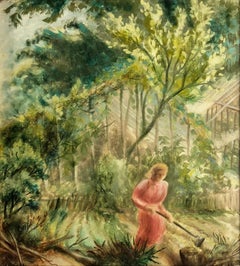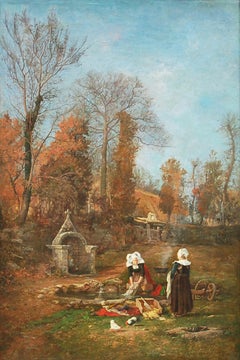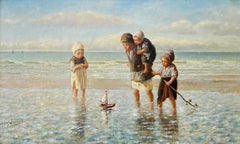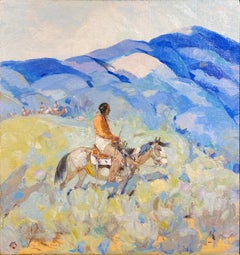Want more images or videos?
Request additional images or videos from the seller
1 of 10
John Martin TracyOn Point (Hunting the Woodcock)c. 1880s
c. 1880s
About the Item
- Creator:John Martin Tracy (1844 - 1893, American)
- Creation Year:c. 1880s
- Dimensions:Height: 16 in (40.64 cm)Width: 24 in (60.96 cm)
- Medium:
- Movement & Style:
- Period:
- Condition:
- Gallery Location:Missouri, MO
- Reference Number:1stDibs: LU74735821151
About the Seller
5.0
Vetted Professional Seller
Every seller passes strict standards for authenticity and reliability
Established in 1970
1stDibs seller since 2017
155 sales on 1stDibs
Typical response time: Several days
Authenticity Guarantee
In the unlikely event there’s an issue with an item’s authenticity, contact us within 1 year for a full refund. DetailsMoney-Back Guarantee
If your item is not as described, is damaged in transit, or does not arrive, contact us within 7 days for a full refund. Details24-Hour Cancellation
You have a 24-hour grace period in which to reconsider your purchase, with no questions asked.Vetted Professional Sellers
Our world-class sellers must adhere to strict standards for service and quality, maintaining the integrity of our listings.Price-Match Guarantee
If you find that a seller listed the same item for a lower price elsewhere, we’ll match it.Trusted Global Delivery
Our best-in-class carrier network provides specialized shipping options worldwide, including custom delivery.You May Also Like
English Victorian early 20th century cottage Garden with woman with flowers
By Ernest Walbourn
Located in Woodbury, CT
This charming painting by Ernest Walbourne is a quintessential example of the artist’s ability to capture the serene beauty of rural life. Known for his idyllic landscapes and depict...
Category
1910s Victorian Landscape Paintings
Materials
Oil, Wood Panel
$8,750 Sale Price
30% Off
Free Shipping
H 28 in W 38 in
19th century English landscape with Oak trees, a stream and sheep on a pathway
Located in Woodbury, CT
19th century English landscape with Oak trees, a stream and sheep on a pathway.
A wonderful classic English landscape dating from the middle of the 19th century. This style of paint...
Category
1860s Victorian Landscape Paintings
Materials
Oil, Wood Panel
$3,250
Free Shipping
H 15 in W 14 in
19th century English landscape with trees, a Harvest Field during Summertime
Located in Woodbury, CT
19th century English landscape with trees, a Harvest Field during Summertime.
A wonderful classic English landscape dating from the middle of the 19th century. This style of paintin...
Category
1860s Victorian Landscape Paintings
Materials
Oil, Wood Panel
$3,250
Free Shipping
H 15 in W 14 in
Antique English Harvest landscape with corn stacks, dog and view of the sea
By Thomas Dingle Junior
Located in Woodbury, CT
Outstanding English Victorian 19th century Harvest landscape.
Thomas Simon Dingle was the son of Thomas Dingle (1818-1904), known as a London landscape painter, but who, according t...
Category
1890s Victorian Landscape Paintings
Materials
Oil, Wood Panel
$2,750
Free Shipping
H 14 in W 16 in
Victorian English 19th century Summer River with horses in a landscape
Located in Woodbury, CT
Wonderful English Victorian River Landscape during the Summer with horses, fields , trees etc
Thomas O Hume was an English landscape painter who exhibit...
Category
1870s Victorian Landscape Paintings
Materials
Oil, Wood Panel
$3,000 Sale Price
20% Off
Free Shipping
H 15 in W 19 in
Victorian English 19th century Autumn/Fall River landscape, with trees and hills
Located in Woodbury, CT
Wonderful English Victorian River Landscape.
Thomas O Hume was an English landscape painter who exhibited from 1864-1892.
He showed his paintings at t...
Category
1870s Victorian Landscape Paintings
Materials
Oil, Wood Panel
$3,000 Sale Price
20% Off
Free Shipping
H 15 in W 19 in
19th Century genre oil painting of two gentlemen in a garden
By Frank Moss Bennett
Located in Nr Broadway, Worcestershire
Frank Moss Bennett
British, (1874-1952)
In the Garden
Oil on panel, signed & dated 1917
Image size: 11 inches x 13.5 inches
Size including frame: 20 inches x 22.5 inches
A charming genre scene of two gentlemen in 18th century costume in a garden by Frank Moss Bennett. The men drink wine and eat fruit at a linen covered table...
Category
Early 20th Century Victorian Figurative Paintings
Materials
Oil, Panel
$4,825
H 20 in W 22.5 in D 3.5 in
19th Century winter landscape oil painting of figures on a frozen lake
By Alexis De Leeuw
Located in Nr Broadway, Worcestershire
Alexis De Leeuw
Belgian, (1822-1900)
A Winter’s Day
Oil on panel, signed
Image size: 10.25 inches x 14.25 inches
Size including frame: 18 inches x 22 inches
Provenance: Cooling Gall...
Category
19th Century Victorian Figurative Paintings
Materials
Oil, Panel
$6,341
H 18 in W 22 in D 2.5 in
19th Century Italian townscape coastal oil painting of Livorno, Gulf of Genoa
By Arthur Joseph Meadows
Located in Nr Broadway, Worcestershire
Arthur Joseph Meadows
British, (1843-1907)
Livorno, Gulf of Genoa
Oil on panel, signed & dated (18)98, with signed & inscribed label on reverse
Image size: 9.75 inches x 11.75 inches
Size including frame: 17.75 inches x 19.75 inches
An attractive townscape depicting fruit sellers at the port of Livorno, Italy by Arthur Joseph Meadows. The scene shows the view looking across from the harbour wall to the church of Santa Caterina...
Category
19th Century Victorian Landscape Paintings
Materials
Oil, Panel
$7,995
H 17.75 in W 19.75 in D 3 in
Edward Charles Williams (Attributed), Wooded River Landscape With Boathouse
By Edward Charles Williams
Located in Cheltenham, GB
This mid-19th-century oil painting, attributed to English artist Edward Charles Williams (1807-1881), depicts a wooded river landscape with a boathouse, cottage, fishermen and figure...
Category
1850s Victorian Landscape Paintings
Materials
Panel, Oil
$2,274
H 20 in W 25 in
More From This Seller
View AllTending the Garden
By Robert Elton Tindall
Located in Missouri, MO
Robert Elton Tindall (1913-1983)
"Tending the Garden" (Girl with a Hoe) c. 1940
Egg Tempera with Resin Oil Glazes on Panel
Signed Lower Left
Site: 10 x 9 inches
Framed: 15 x 14 inch...
Category
Mid-20th Century American Modern Figurative Paintings
Materials
Egg Tempera, Wood Panel
Price Upon Request
Breton Chores
Located in Missouri, MO
Clement Nye Swift
"Breton Chores" 1870
Oil on Canvas
Signed and Dated Lower Right
Canvas Size: approx 27 x18 inches
Framed Size: approx 34 x 35 inches
Provenance: Private Midwes...
Category
1870s Victorian Figurative Paintings
Materials
Canvas, Oil
Price Upon Request
Children at the Seashore
By Josef Israels
Located in Missouri, MO
Children at the Seashore
By Josef Israels (1824-1911)
Unframed: 9" x 15"
Framed: 17.5" x 23.5"
Signed Lower Left
Born in Groningen, Holland, in 1824, Josef Israels was brought up in the traditions of the Jewish faith and destined for the rabbinate. His interest in drawing grew stronger with age however, and in 1840 his father finally relented, sending him to Amsterdam. There he spent his days working in the studio of Jan Kruseman and his evenings painting at the Royal Academy under Jan Pieneman, both leading portrait painters. In Paris, Israels studied a short time with the historical painter Francois Picot...
Category
19th Century Realist Landscape Paintings
Materials
Oil, Panel
Price Upon Request
The Deer Hunters
Located in Missouri, MO
Laverne Nelson Black (American, 1887-1938)
"The Deer Hunters"
Signed Lower Left
Canvas: 24 x 22 inches
Framed: 30.5 x 28.5 inches
Born in Viola,...
Category
Early 20th Century American Impressionist Landscape Paintings
Materials
Canvas, Oil
Price Upon Request
A Day in June, Scene Eastchest, New York
By Edward B. Gay
Located in Missouri, MO
"A Day in June, Scene Eastchest, New York" 1898
Edward Gay (Irish, American, 1837-1928)
Oil on Canvas
Complimented by original frame in great condition
Signed and Dated Lower Right
T...
Category
1890s Hudson River School Landscape Paintings
Materials
Canvas, Oil
Mad River
By Julio Larraz
Located in Missouri, MO
Mad River, 1996
Julio Larraz (Cuban, 1944)
Signed and Dated Lower Right
41 x 49 inches
43 x 51 inches with frame
Provenance: Atrium Gallery, 1999
Accomplished painter, sculptor, and...
Category
1990s Contemporary Figurative Paintings
Materials
Canvas, Oil
Price Upon Request



